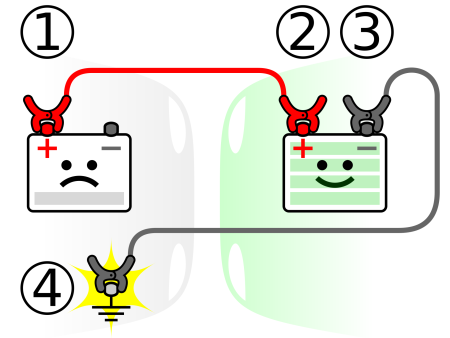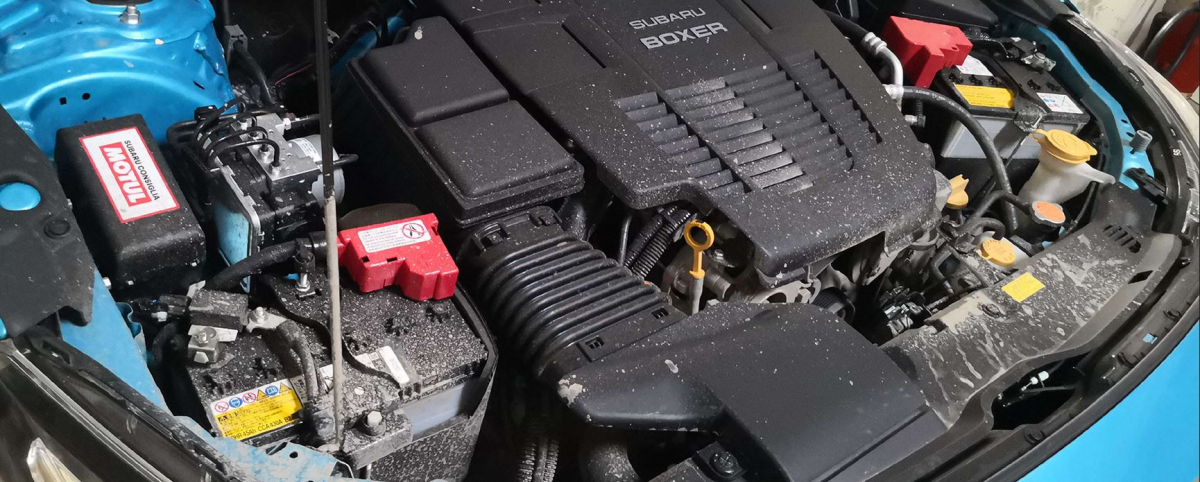HOW-TO: PERFORMING A JUMP START
HOW TO JUMP START CORRECTLY
You can always rely on your Banner battery if it has been well maintained. But suppose your neighbour is struggling to start their car?
We will show you what to look out for when performing a jump start.

Performing a jump start with cables
- For performing a jump start with starter cables, we recommend the use of standardised starter cables (e.g. according to DIN 72553).
- Follow the instructions for use for the starter cables.
- Only connect batteries of the same nominal voltage.
- The vehicles must not touch each other.
- Disconnect both vehicle engines before connecting.
- Always ensure that neither you nor the batteries are electrostatically charged.
- Is the vehicle equipped with a battery master switch? If YES, then always check that the battery master switch is plugged in.
- First connect the two positive terminals 1 (battery from the vehicle in need of assistance) to 2 (battery from the donor vehicle), then connect the negative terminal 3 (battery from the donor vehicle) to the earth terminal on the vehicle in need of assistance 4 (earth = metallic smooth point away from the battery). Observe the instructions of the vehicle manufacturer.
- Now start the vehicle in need of assistance for max. 15 seconds without starting the donor vehicle.
- When disconnecting, disconnect the cables in reverse order.
Do not jump-start an electric car! (BEV Battery Electric Vehicle)
For technical reasons, the jump-start points of electric cars, if available at all, are not designed to jump-start other vehicles. In this case, it is better to seek the help of a breakdown service. Conversely, however, an internal combustion engine may properly jump-start an electric car.
Please also note: A hybrid car is usually not suitable as a donor vehicle! (applies primarily to mild, full and plug-in hybrids, not to micro-hybrids - can be used as a donor vehicle)
The car owner's manual will tell you exactly whether your hybrid car is suitable as a power source. This is usually not the case, as the 12V wiring harnesses for this type of drive are usually weaker than those of conventional vehicles. In extreme cases, serious electronic faults can occur in the donor car or at least error codes can be generated that are often only noticed later. n this case, it is better to seek the help of a breakdown service. Conversely, however, a combustion engine may properly jump-start a hybrid car. All the necessary information can be found in the owner's manual.
Our Banner tip: Due to the sensitive electronics in the vehicle, jump-starting should generally only be carried out with a Banner booster. Car-to-car jump leads can cause voltage spikes when disconnected, damaging or even destroying the vehicle's electronics. It is therefore essential to follow the instructions below when using starter cables.

Donor vehicle does not start, why and why not!
The donor vehicle is often started, now let's assume it runs at idle (idle speed) with an alternator output of approx. 50-70%. Now the fatal thing happens: the accelerator is almost always pressed hard to increase the engine speed and the charging voltage, in the mistaken assumption that even more starting power is needed.
Unfortunately, this happens too often: with a bit of luck, only the starter cables burn out (depending on the cable cross-section*), in the worst case, the control units of the vehicle in need of help are damaged - due to overvoltages or voltage peaks. Therefore, please be sure to follow the Banner How-To jump-start instructions.
Another Banner tip: Number of starting attempts max. 3-5, length of each starting attempt max. 15 seconds - otherwise unburnt fuel could get into the catalytic converter of vehicles with catalytic converter, with all the negative side effects.
PS: Let's completely disregard the driving mode in which the assisting vehicle is currently providing jump-starting assistance. There are cars with voltages of up to 15.3V in normal driving or sport mode!
* For copper cables, the cross-section should be at least 16 mm², for aluminium cables at least 25 mm². From 2 litres capacity, a cross-section of at least 25 mm² (aluminium 40 mm²) is advisable for copper cables. For even larger engines (3 litres and more), copper jump leads with a cross-section of 35 mm² (aluminium 55 mm²) should be selected. If no professional jump starter (booster) is available.

The jumper cables should definitely comply with DIN standard 72553 or ISO standard 6722.
Info on cable material: Aluminium cables are not quite as conductive as copper and must therefore be thicker accordingly (as noted above).
Banner tip on cable length: For sufficient room to move and for the cables to be sufficient from encoder to encoder, the cables should be at least 2 metres long, ideally and at most 3 to 4 metres long.
Please note: Extremely long cables are practical if the broken-down vehicle is in an awkward position and the rescue vehicle cannot be placed directly next to it for bridging. However, a thicker cable cross-section is necessary because the electrical resistance increases with the length of the cable!

Where is the battery located?
The car battery is not always installed in the engine compartment, but can also be located in the interior/passenger compartment or boot.
In principle, the jump start procedure remains the same, but whenever possible, use the jump start connections in the engine compartment of the vehicle requiring assistance.
Banner tip: On some car models, simply flip up the red cover of the jump start connection; on other cars, the red cover cap on the jump start connection can usually be pushed back to the right with a twist using the positive clamp from the booster or jump start cable. A quick look at the car operating instructions can be really helpful here.
Do not forget! Safety goggles and gloves are absolutely necessary before jump-starting.
Never jump-start a frozen battery (with liquid electrolyte); this can only be attempted after the battery has thawed.
A brief explanation of the effect of cold on the battery and its consequences:
An acid density (at +27 degrees Celsius) of 1.28 kg/l (= open-circuit voltage of conventional battery ≥ approx. 12.7 V) also means an optimum starting position in terms of freezing point. A fully charged battery (100% state of charge) only freezes at approx. -60 degrees Celsius!
However, caution is advised with discharged batteries. As there is almost no water in the battery when it is discharged, the freezing point rises to almost 0 degrees Celsius! Discharged batteries can therefore freeze and, in extreme cases, even burst open!


You might also be interested in the following





